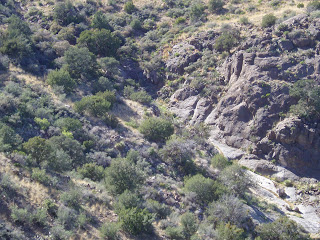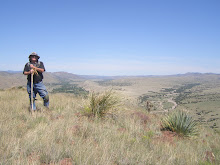3 examples of field positions



 These are four different firing "positions" I've found just in the Florida Mountains, east of Deming, NM. They are located near a known "battle site." They are interesting in that most are faced east, north or south, but one I found, was faced west, and would have covered what I think was an escape route over the top of the range.
These are four different firing "positions" I've found just in the Florida Mountains, east of Deming, NM. They are located near a known "battle site." They are interesting in that most are faced east, north or south, but one I found, was faced west, and would have covered what I think was an escape route over the top of the range.For what it is worth, the Floridas are one of my favorite hiking places. I've mostly hiked on the east side, because there's not much development on that side. On the west side, development is all around, and it is demoralizing to me to hike all day and see a city spreading out beyond me, slowly creeping farther up the mountains themseves.
I really like the isolation I find on the East side. It is an illusion, of course, but nonetheless, I can attest to the statement that in over 50 hikes in the Floridas, I've NEVER run into a single hiker hiking where I am. I have SEEN a few hikers from a distance, and on one occasion, I ran into a man who was hiking in a cañon that is the only place in the entire range set up for hiking.
The photo above, left, actually has running water after rains or during snow melt. There is a pipe (heavy plastic) that is inserted into the spring that the water emanates from, and which runs down to tanks, far below and to the east. I've seen water glistening off the rocks there, and it is, in fact, one of the reasons the fighting positions are located near this place. It was, a place where water flowed freely until the 1870s, when ranchers began to tank it up.
The pointed rock in one photo is what I call a "marker" or "pointer" rock. I believe that rock points to the lowest part of the Floridas. I believe that area is where Apaches would be able to take women and children on foot, or horse, over from the east to west side, and the firing positions on the ridge line I've identified are focused on luring anyone trying to chase the Apaches into a fire fight there.
The photo that has a rock bench and "mortar in bedrock holes" in it is on a now dry arroyo. I've seen water in it once, but I suspect 125 years ago, and certainly 300 years ago, when the Apache began moving around in the Floridas, there was water more often.
The holes, I should note, retain water, in the summer and snow melt of winter & spring. I've found some deep enough to contain 2 - 3 liters of water each. I believe that Apaches may have used them, also, for caches, simply by mudding up the top, and then laying rocks over them to conceal them. I've found one or two such holes like that. While these holes might allow five or six women to work on grinding grains or berries (none show those stains, however), they also would be in prime positions to collect water when the rains come. Placed in known drainage paths on the rocks, the Apache could have ground these out from natural holes in the rock, making them wider and deeper. In this way, if being chased by enemies in the summer months, when the summer rains come, the Apaches might know there would be water in such locations. They would either drink the water up themselves, or, allow their horses to consume the water ... preventing chasers from doing so.


0 Comments:
Post a Comment
Subscribe to Post Comments [Atom]
<< Home